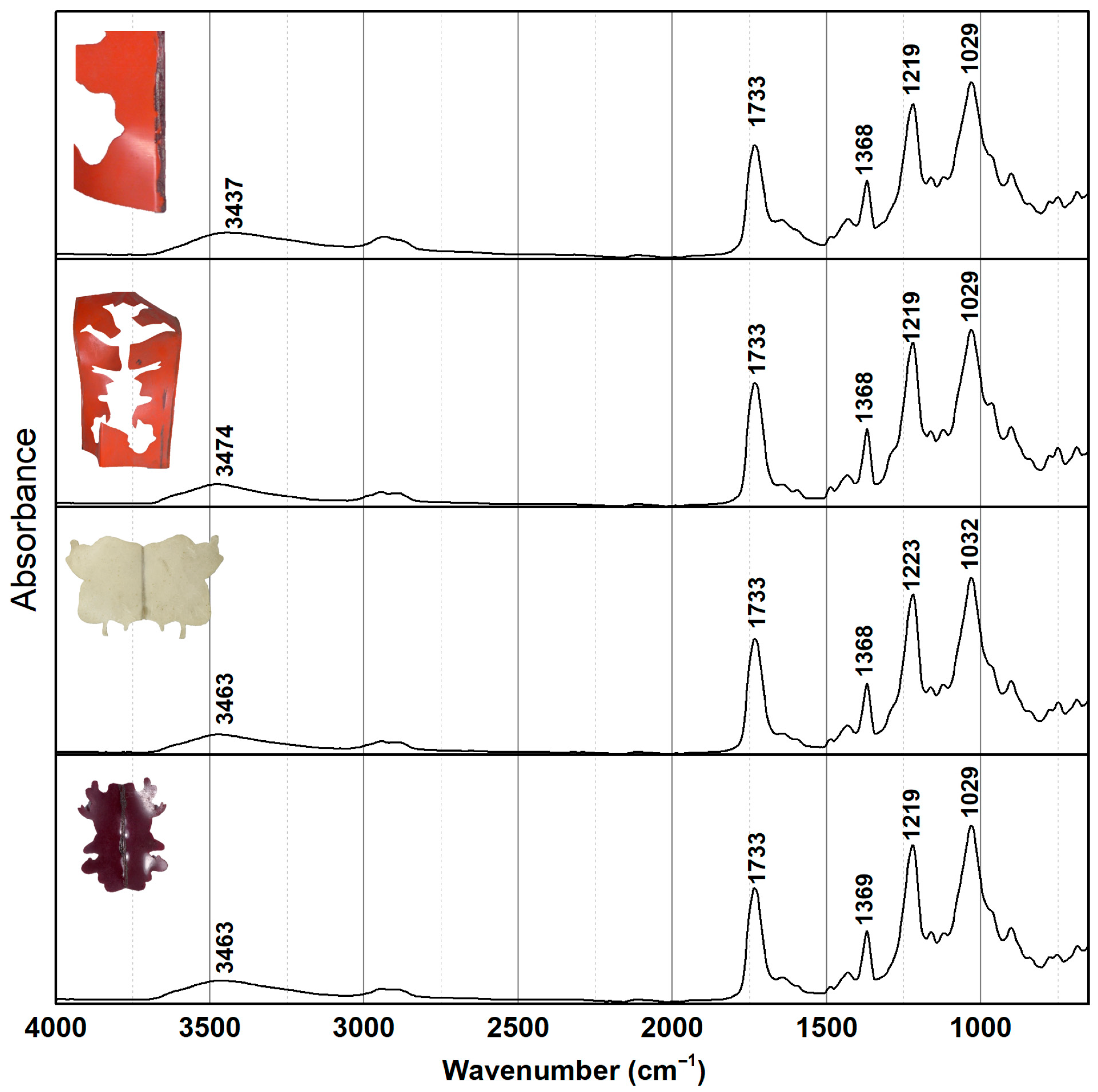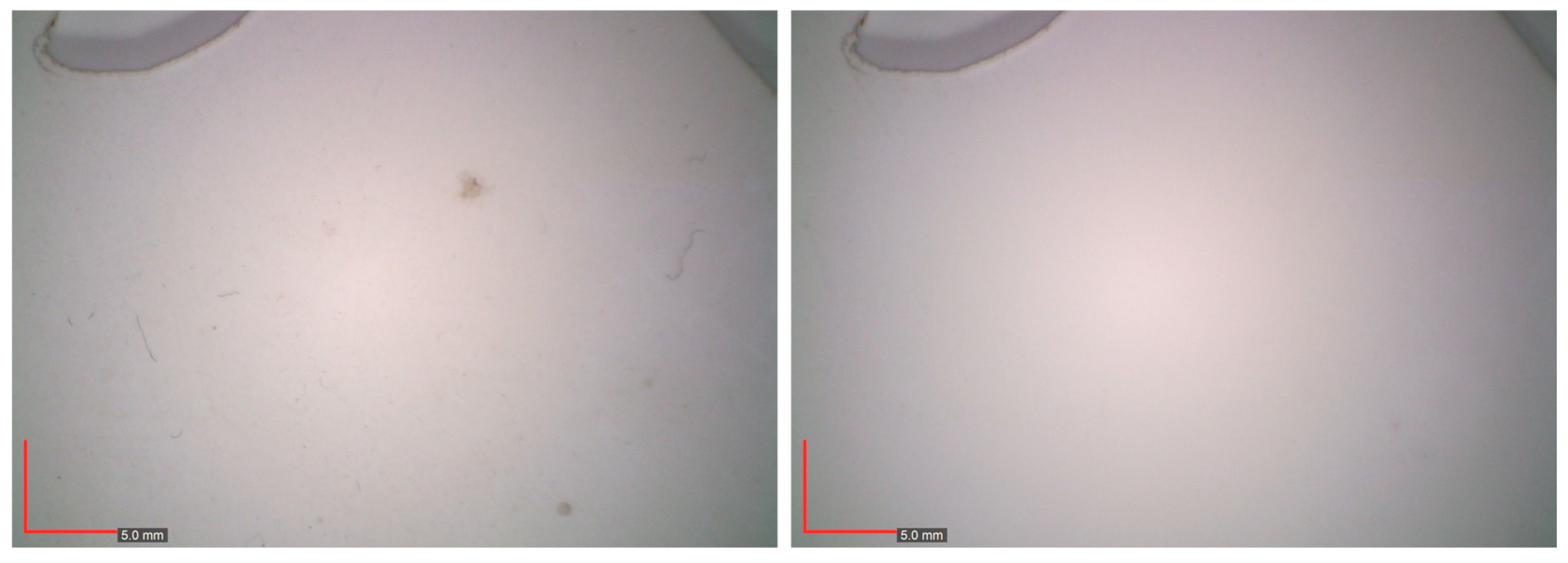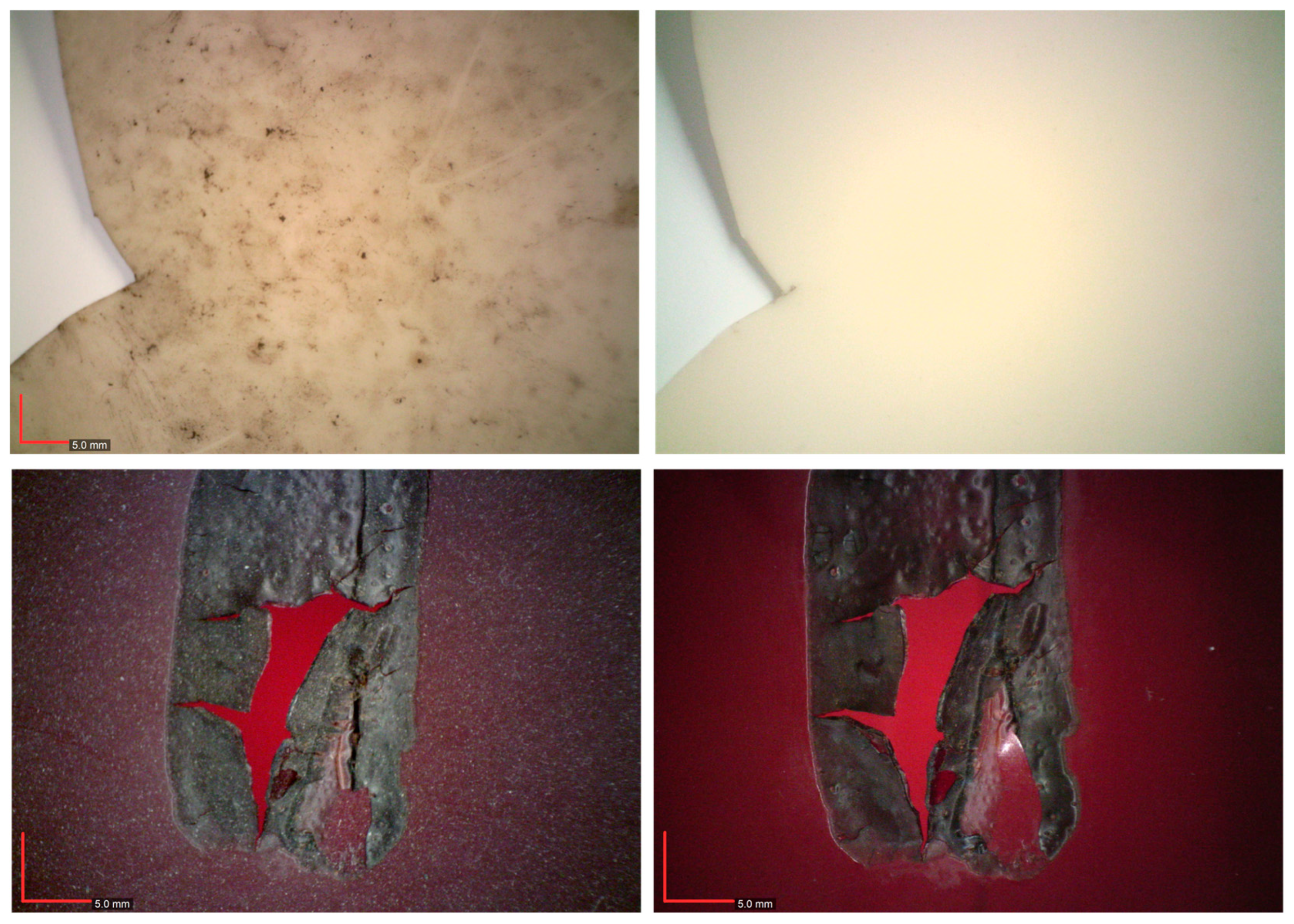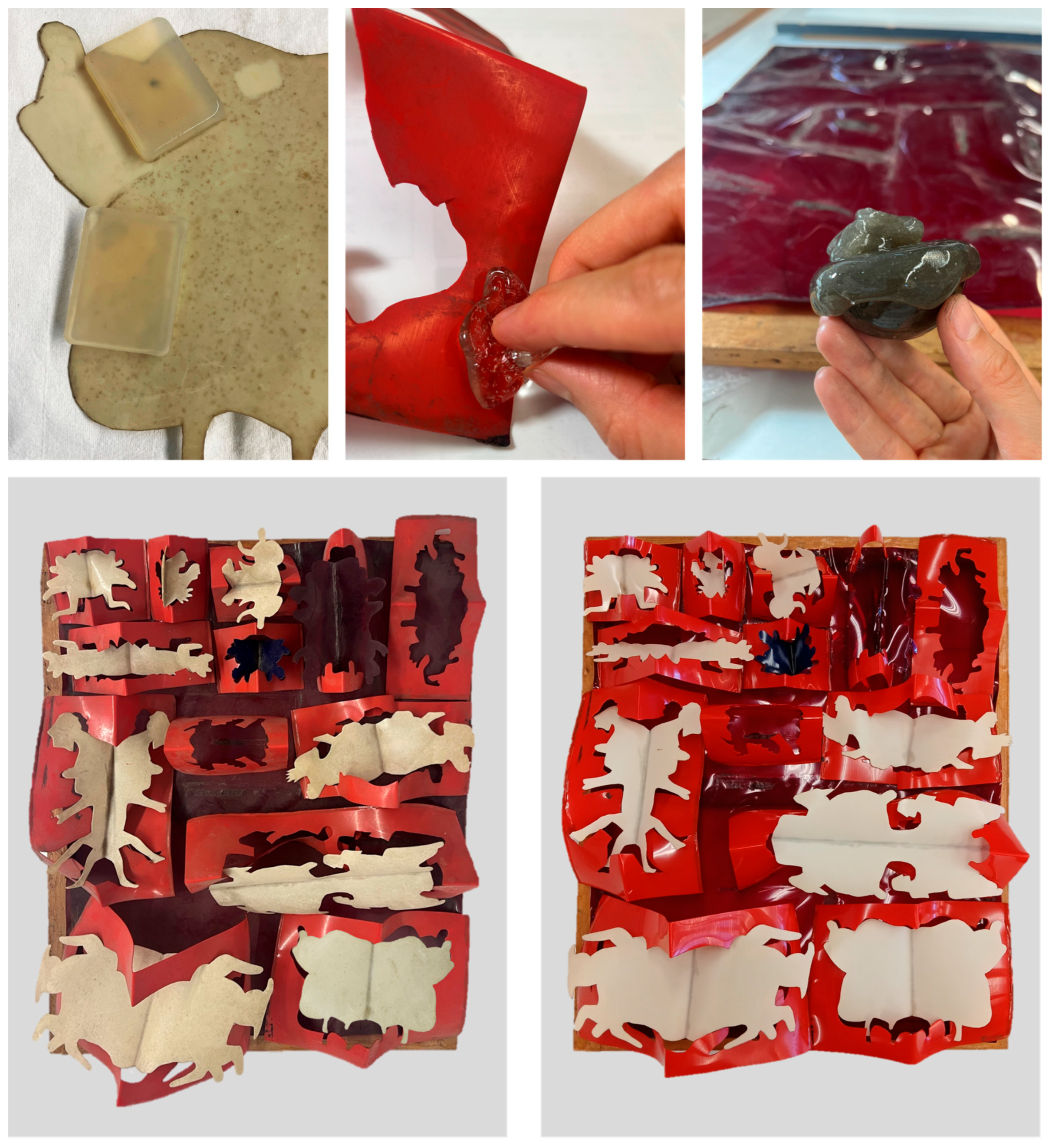Aging Characterization and Preliminary Exploration of Gel-Based Cleaning of Cellulose Acetate in José Escada’s Le Rituel
Abstract
1. Introduction
José Escada and the Challenges of Cellulose Acetate Conservation
2. Results and Discussion
2.1. Artwork Condition
2.2. Naturally Aged Replica
2.3. Cleaning Tests in Cellulose Acetate Replica and Artwork
3. Conclusions
4. Materials and Methods
4.1. Gels: Preparation and Application
4.2. Examination and Analytical Instrumentation
4.3. Cleaning Assessment
Supplementary Materials
Author Contributions
Funding
Institutional Review Board Statement
Informed Consent Statement
Data Availability Statement
Acknowledgments
Conflicts of Interest
Abbreviations
| CA | Cellulose acetate |
| PVAl | Poly(vinyl alcohol) |
| CR | chloroprene |
References
- Da Ros, S.; Aliev, A.E.; del Gaudio, I.; King, R.; Pokorska, A.; Kearney, M.; Curran, K. Characterising Plasticised Cellulose Acetate-Based Historic Artefacts by NMR Spectroscopy: A New Approach for Quantifying the Degree of Substitution and Diethyl Phthalate Contents. Polym. Degrad. Stab. 2021, 183, 109420. [Google Scholar] [CrossRef]
- Nunes, S.; Ramacciotti, F.; Neves, A.; Angelin, E.M.; Ramos, A.M.; Roldão, É.; Wallaszkovits, N.; Alejo Armijo, A.; Melo, M.J. A Diagnostic Tool for Assessing the Conservation Condition of Cellulose Nitrate and Acetate in Heritage Collections: Quantifying the Degree of Substitution by Infrared Spectroscopy. Herit. Sci. 2020, 8, 33. [Google Scholar] [CrossRef]
- Nunes, S. Acetato de Celulose em Património Cultural: O Grau de Substituição como Indicador da Degradação. Master’s Thesis, Departamento de Conservação e Restauro, Faculdade de Ciências e Tecnologia, Universidade Nova de Lisboa, Lisbon, Portugal, December 2019. Available online: https://run.unl.pt/handle/10362/126752 (accessed on 16 September 2025).
- Shashoua, Y. Conservation of Plastics: Materials Science, Degradation and Preservation; Butterworth-Heinemann: Oxford, UK, 2008. [Google Scholar] [CrossRef]
- Liu, L.; Gong, D.; Bratasz, Ł.; Zhu, Z.; Wang, C. Degradation Markers and Plasticizer Loss of Cellulose Acetate Films during Ageing. Polym. Degrad. Stab. 2019, 168, 108952. [Google Scholar] [CrossRef]
- Moncrieff, A.; Littlejohn, D.; Cooke, R.; Weaver, G. Science for Conservators, Volume 2: Cleaning; Routledge: London, UK, 1984. [Google Scholar]
- Balcar, N.; Laganà, A.; van Oosten, T.; Learner, T. Studies in Cleaning Plastics. In POPART: Preservation of Plastic ARTefacts in Museum Collections; CTHS: Paris, France, 2012; pp. 221–265. [Google Scholar]
- Shashoua, Y.; Alterini, M.; Pastorelli, G.; Cone, L. From Microfiber Cloths to Poly(vinyl alcohol) Hydrogels—Conservation Cleaning of Plastics Heritage. J. Cult. Herit. 2021, 52, 38–43. [Google Scholar] [CrossRef]
- Khaksar-Baghan, N.; Koochakzaei, A.; Hamzavi, Y. An Overview of Gel-Based Cleaning Approaches for Art Conservation. Herit. Sci. 2024, 12, 248. [Google Scholar] [CrossRef]
- Stoveland, L.P.; Frøysaker, T.; Stols-Witlox, M.; Grøntoft, T.; Steindal, C.C.; Madden, O.; Ormsby, B. Evaluation of Novel Cleaning Systems on Mock-Ups of Unvarnished Oil Paint and Chalk-Glue Ground within the Munch Aula Paintings Project. Herit. Sci. 2021, 9, 144. [Google Scholar] [CrossRef]
- Pensabene Buemi, L.; Petruzzellis, M.L.; Chelazzi, D.; Baglioni, M.; Mastrangelo, R.; Giorgi, R.; Baglioni, P. Twin-Chain Polymer Networks Loaded with Nanostructured Fluids for the Selective Removal of a Non-Original Varnish from Picasso’s “L’Atelier” at the Peggy Guggenheim Collection, Venice. Herit. Sci. 2020, 8, 77. [Google Scholar] [CrossRef]
- Lazzari, M.; Reggio, D. What Fate for Plastics in Artworks? An Overview of Their Identification and Degradative Behaviour. Polymers 2021, 13, 883. [Google Scholar] [CrossRef]
- Aguiar, M.J. Artistas Portugueses na Coleção da Fundação de Serralves; BPI, Fundação de Serralves: Porto, Portugal, 2009. [Google Scholar]
- Alfaro, C.; Braz, I.A.; Pires-Vieira, V.L. Nouveaux Réalistes|KWY, Obras em Coleções Portuguesas, 1st ed.; Proteína: Lisboa, Portugal, 2009. [Google Scholar]
- CAMB. Os Artistas da KWY na Coleção Manuel de Brito; Folheto da Exposição, Centro de Arte Manuel de Brito: Algés, Portugal, 2016. [Google Scholar]
- Babo, S. Estudo e Conservação da Obra “Dans la Plage” de José Escada. A Degradação do Acetato de Celulose e o Tratamento de Deformações em Materiais Termoplásticos. Bachelor’s Thesis, Relatório de Estágio, Faculdade de Ciências e Tecnologia, Universidade Nova de Lisboa, Caparica, Portugal, 2006. [Google Scholar]
- Stavroudis, C. Sorting out surfactants. WAAC Newsl. 2009, 31, 18–21. [Google Scholar]
- Sansonetti, A.; Bertasa, M.; Canevali, C.; Rabbolini, A.; Anzani, M.; Scalarone, D. A Review in Using Agar Gels for Cleaning Art Surfaces. J. Cult. Herit. 2020, 44, 285–296. [Google Scholar] [CrossRef]
- Giordano, A.; Caruso, M.R.; Lazzara, G. New Tool for Sustainable Treatments: Agar Spray—Research and Practice. Herit. Sci. 2022, 10, 123. [Google Scholar] [CrossRef]
- Richard, F.; Hermans, J.J.; Angelova, L. Rigid Solvent-Gels in Paper Conservation: A New Approach to Sticky Problems. J. Pap. Conserv. 2024, 25, 86–106. [Google Scholar] [CrossRef]
- Sansonetti, A.; Riminesi, C.; Mironiouk, S.; Proietti, N.; Di Tullio, V.; Nisticò, R.; Sacchi, B.; Canevali, C. Gel Cleaning in Heritage: Comparison of the Water Release among Gels and Traditional Pads. Gels 2024, 10, 708. [Google Scholar] [CrossRef]
- Morlotti, M.; Forlani, F.; Saccani, I.; Sansonetti, A. Evaluation of Enzyme Agarose Gels for Cleaning Complex Substrates in Cultural Heritage. Gels 2023, 10, 14. [Google Scholar] [CrossRef] [PubMed]
- Riedo, C.; Caldera, F.; Poli, T.; Chiantore, O. Poly(vinyl alcohol)-Borate Hydrogels with Improved Features for the Cleaning of Cultural Heritage Surfaces. Herit. Sci. 2015, 3, 23. [Google Scholar] [CrossRef]
- Stagno, V.; D’Amato, R.; Ghigo, M.; Sebastiani, F.; Mattea, C.; Alberti, E. Non-Invasive Assessment of PVA–Borax Hydrogel Effectiveness in Removing Metal Corrosion Products on Stones by Portable NMR. Gels 2021, 7, 265. [Google Scholar] [CrossRef]
- Al-Emam, E.; Motawea, A.G.; Janssens, K.; Caen, J. Evaluation of Polyvinyl Alcohol–Borax/Agarose (PVA–B/AG) Blend Hydrogels for Removal of Deteriorated Consolidants from Ancient Egyptian Wall Paintings. Herit. Sci. 2019, 7, 22. [Google Scholar] [CrossRef]
- Angelova, L.V.; Berrie, B.H.; de Ghetaldi, K.; Kerr, A.; Weiss, R.G. Partially Hydrolyzed Poly(vinyl acetate)–Borax-Based Gel-Like Materials for Conservation of Art: Characterization and Applications. Stud. Conserv. 2015, 60, 227–244. [Google Scholar] [CrossRef]
- Kemper, B.; Herm, C. Transparent Figures: Researching and Preserving Objects of Cellulose Acetate. Polymers 2023, 15, 2838. [Google Scholar] [CrossRef]
- Cudell, A.; Veiga, R.; van Oosten, T.; Laganà, A.; van Keulen, H.; Venade, I. Strategies for the Conservation of Cellulose Acetate Artworks—Case Study of Two Plastic Books. In ICOM-CC 16th Triennial Meeting Preprints, Proceedings of the ICOM Committee for Conservation, Lisbon, Portugal, 19–23 September 2011; Critério Artes Gráficas, Lda.: Almada, Portugal, 2011; ISBN 978-989-97522-0-7. [Google Scholar]
- Curran, K.; Underhill, M.; Grau-Bové, J.; Fearn, T.; Strlič, M. Classifying Degraded Modern Polymeric Museum Artefacts by Their Smell. Angew. Chem. Int. Ed. 2018, 57, 7336–7340. [Google Scholar] [CrossRef] [PubMed]
- Wolbers, R. Cleaning Painted Surfaces: Aqueous Methods; Archetype Publications: London, UK, 2000. [Google Scholar]
- Chelazzi, D.; Bordes, R.; Giorgi, R.; Holmberg, K.; Baglioni, P. The Use of Surfactants in the Cleaning of Works of Art. Curr. Opin. Colloid Interface Sci. 2020, 45, 108–123. [Google Scholar] [CrossRef]
- Casoli, A.; Cremonesi, P.; Isca, C.; Groppetti, R.; Pini, S.; Senin, N. Evaluation of the Effect of Cleaning on the Morphological Properties of Ancient Paper Surface. Cellulose 2013, 20, 2027–2043. [Google Scholar] [CrossRef]
- D’Amico, M.C.; Gianferrari, M.; Del Bianco, A. Pace by Nino Migliori: Examination, Analysis and Treatment of a Contemporary Color Photography Experimental Artwork. Heritage 2022, 6, 90–111. [Google Scholar] [CrossRef]
- Marseglia, B.; Del Bianco, A.; Monaco, C.R. The Relationship between Conservators and Living Artists. Account and Reflections from a Direct Experience: The Sacri Indici (Sacred Indexes) Exhibition. J. Pap. Conserv. 2023, 24, 108–132. [Google Scholar] [CrossRef]
- Bartoletti, A.; Barker, R.; Chelazzi, D.; Bonelli, N.; Baglioni, P.; Lee, J.; Phenix, A.; Degano, I.; van den Berg, K.J.; Burnstock, A.; et al. Reviving WHAAM!: A Comparative Evaluation of Cleaning Systems for the Conservation Treatment of Roy Lichtenstein’s Iconic Painting. Herit. Sci. 2020, 8, 50. [Google Scholar] [CrossRef]
- Vandenabeele, P.; Moens, L.; Edwards, H.G.M.; Dams, R. Raman spectroscopic database of azo pigments and application to modern art studies. J. Raman Spectrosc. 2000, 31, 509–517. [Google Scholar] [CrossRef]
- Schulte, K.; Brzezinka, K.; Lutzenberger, H.S.; Panne, U. Raman spectroscopy of synthetic organic pigments used in 20th century works of art. J. Raman Spectrosc. 2008, 39, 1455–1463. [Google Scholar] [CrossRef]
- Documents. Mazzucchelli 1849. Available online: https://www.mazzucchelli1849.it/pages/documents?locale=en (accessed on 28 November 2023).







| Module | Average DS | Standard Deviation |
|---|---|---|
| Red, near adhesive | 1.71 | 0.19 |
| Red, far from adhesive | 2.12 | 0.06 |
| Beige | 2.10 | 0.10 |
| Dark Red | 2.00 | 0.22 |
Disclaimer/Publisher’s Note: The statements, opinions and data contained in all publications are solely those of the individual author(s) and contributor(s) and not of MDPI and/or the editor(s). MDPI and/or the editor(s) disclaim responsibility for any injury to people or property resulting from any ideas, methods, instructions or products referred to in the content. |
© 2025 by the authors. Licensee MDPI, Basel, Switzerland. This article is an open access article distributed under the terms and conditions of the Creative Commons Attribution (CC BY) license (https://creativecommons.org/licenses/by/4.0/).
Share and Cite
França de Sá, S.; Babo, S.; Neves, A.; Garcia, A.; Nunes, S.; Cairoli, A.; Melo, M.J. Aging Characterization and Preliminary Exploration of Gel-Based Cleaning of Cellulose Acetate in José Escada’s Le Rituel. Gels 2025, 11, 954. https://doi.org/10.3390/gels11120954
França de Sá S, Babo S, Neves A, Garcia A, Nunes S, Cairoli A, Melo MJ. Aging Characterization and Preliminary Exploration of Gel-Based Cleaning of Cellulose Acetate in José Escada’s Le Rituel. Gels. 2025; 11(12):954. https://doi.org/10.3390/gels11120954
Chicago/Turabian StyleFrança de Sá, Susana, Sara Babo, Artur Neves, Alexandra Garcia, Sofia Nunes, Aurora Cairoli, and Maria João Melo. 2025. "Aging Characterization and Preliminary Exploration of Gel-Based Cleaning of Cellulose Acetate in José Escada’s Le Rituel" Gels 11, no. 12: 954. https://doi.org/10.3390/gels11120954
APA StyleFrança de Sá, S., Babo, S., Neves, A., Garcia, A., Nunes, S., Cairoli, A., & Melo, M. J. (2025). Aging Characterization and Preliminary Exploration of Gel-Based Cleaning of Cellulose Acetate in José Escada’s Le Rituel. Gels, 11(12), 954. https://doi.org/10.3390/gels11120954






